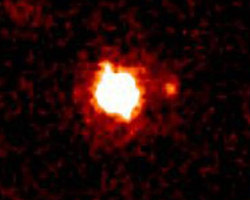
![]() Main Page
Main Page
![]() Feedback
Feedback
 The Author
The Author
 News
News
 Search
Search
 The Planets
The Planets
 Mercury
Mercury
 Venus
Venus
 Earth
Earth
 Mars
Mars
 Jupiter
Jupiter
 Saturn
Saturn
 Uranus
Uranus
 Neptune
Neptune
 Pluto
Pluto
 Dwarf Planets
Dwarf Planets
 The Solar System
The Solar System
 The Sun
The Sun
 The Moon
The Moon
 Meteors
Meteors
 Comets
Comets
 Asteroids
Asteroids
 Amazing facts
Amazing facts
 Other
Resources
Other
Resources
 Poster Store
Poster Store
 Multimedia
Multimedia
 Links
Links
 Awards
Awards
 Glossary
Glossary
 Astronomers
Astronomers
 Webrings
Webrings
 Bibliography
Bibliography
Dwarf Planets
|
There are currently three known dwarf planets in the Solar System: Ceres, Pluto and Eris. Ceres is found in the asteroid belt, and Pluto and Eris are beyond the orbit of Neptune. What is a Dwarf Planet? A dwarf planet is defined as being a celestial body which fulfills the follwing four criteria: it must orbit the Sun, it must have sufficient mass that its gravity causes it to be round or almost round in shape, it must not be another object's satellite, and it must not have cleared the neighbourhood around its orbit. In other words, a dwarf planet is an object orbiting the Sun which is not quite big enough to be a planet, but which is bigger than a mere asteroid or Kuiper Belt Object. Also, it is important to note that a 'dwarf planet' is a totally seperate category of object to 'planet', thus a dwarf planet is not a subcategory of 'planet', despite what the name suggests, but a different class of object in its own right.
The first three criteria are quite self-explanatory and need little interpretation, however there has been some confusion about the final criterion mentioned - that a dwarf planet must not have 'cleared the neighbourhood' around its orbit. This criterion was included so as to exclude any of the 8 'traditional' planets from falling under the dwarf planet category, as they have all broadly cleared the area around their orbital trajectories from other objects such as asteroids. Dwarfs such as Ceres or Pluto do not however fall into this category - Ceres for instance is found in the asteroid belt, and as such is surrounded by different objects, and Pluto's orbit takes it into the Kuiper Belt, which is a region containing many small objects. It has been argued however that such a loose definition of this final criterion means that Neptune should also be classified as a dwarf planet, as it has not 'cleared the neighbourhood' around its orbit of Pluto or Charon. It is therefore quite likely that the International Astronomical Union will redifine the dwarf planet category with more stringent criteria when the need arises in the coming years. The Dwarf Planets: Ceres By far the first dwarf planet to be discovered, Ceres was previously well known as being the largest asteroid in the asteroid belt. Discovered in 1801 by Italian astronomer Giuseppe Piazzi, Ceres is 940km in diameter, and orbits the Sun at an average distance of 2.7 AU, in the asteroid belt between Mars and Jupiter. Ceres is only just too faint to be seen with the naked eye, but can be seen easily with a telescope. It is thought that Ceres probably has a rocky inner core surrounded by an icy mantle and with a thin, dusty crust on the outside. It is also suspected that Ceres may have a thin atmosphere, due to its relatively warm surface temperature (up to 239K). Pluto At 2,320 km in diameter, Pluto is considerably bigger than Ceres, but not quite as big as Eris. For more informaiton on Pluto, see the Pluto Overview page
Eris Discovered in October 2003, Eris is the largest known dwarf planet in the Solar System. Recent measurements estimate its diameter to be about 2400km - slightly bigger than Pluto - and its average surface temperature to be a chilly 30K (-243°C), making Eris the coldest known dwarf planet. Eris has a moon called Dysnomia, discovered in 2005. Eris was named after the Goddess of Discord in Greek mythology - a very apt name considering the fuss that was kicked up shortly after its discovery over whether or not it should be classified as a planet. Why do we need them? The International Astronomers Union officially created the category of dwarf planet in 2006 specifically to describe objects such as Pluto and the recently discovered Eris, so that they would not need to be classified as planets. The fear was that many other objects similar in size to Pluto would be discovered in the outer Solar System in the coming years, and so with no action we may soon have ended up with a list of 40 or 50 planets. Therefore, in order to preserve the special status of the 8 traditional planets, which were seen to be sufficiently different to the new arrivals to warrant being in a seperate category category, the term 'dwarf planet' was created to describe most of the new large bodies which are expected to be discovered over the next few decades in our Solar System. |
||||||||||||||
Comets Links |
||||||||||||||
|
||||||||||||||


